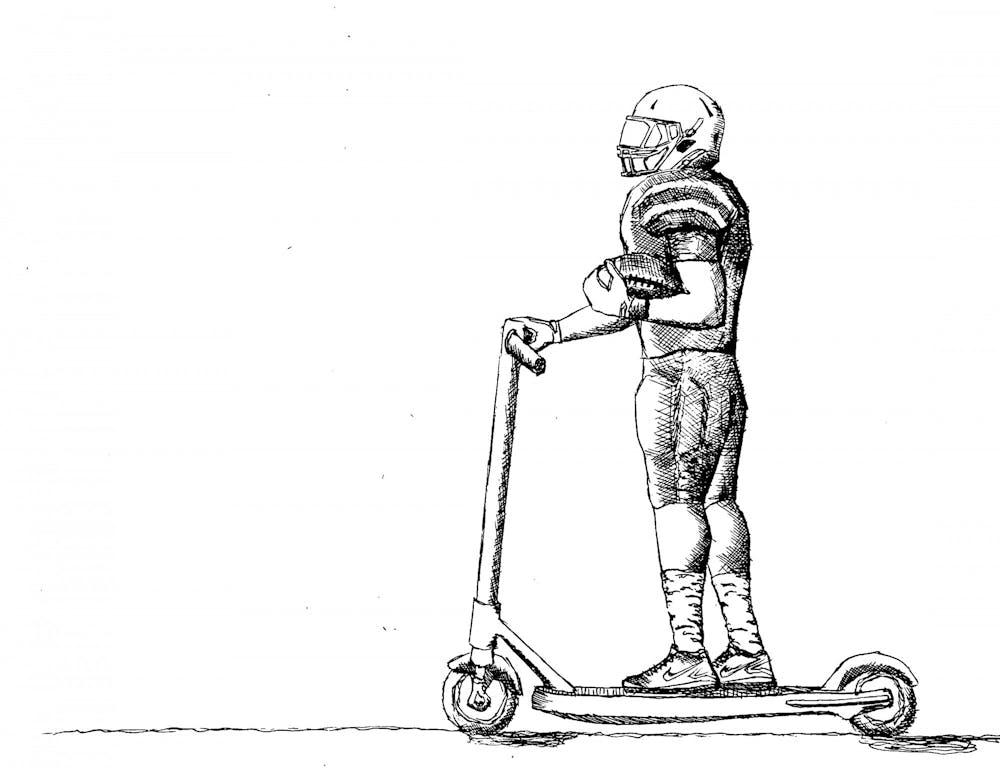Walk behind the Olney-Margolies Athletics Center, and you’ll find a sea of motorized scooters — orange, rentable Spin scooters stand ready to be unlocked by a phone, while U-locks secure privately-owned matte gray and jet black scooters to a bike rack.
They zip through campus, down Thayer Street, in front of the Sharpe Refectory, past the empty grass where Blueno once sat. And as the scooter speeds by, the rider is often seen sporting that unmistakable team-issued backpack.
According to five student-athletes who spoke to The Herald, both rented and personally owned two-wheelers have ingrained themselves in the culture of the University’s student-athletes.
With a full student body finally back on campus, rental scooter use has soared, according to Sam Andrews, a community engagement liaison for Spin. Ridership has consistently broken weekly and daily records since late summer, he said.
“The most student riders that we have (in the Providence area) are Brown students,” Andrews said.
For athletes, scooters — which charge overnight and have batteries that last all day — help carve out time otherwise lost to transit between classes and practice.
For example, the baseball team’s Ryan Marra ’23 lives in Grad Center — one of the southernmost dorms on campus — and has to commute almost a mile to the athletics complex, one of the northernmost points.
“I was spending a lot of time walking to places, on top of working out and practicing,” he said. Marra noted that he often goes back and forth from main campus to the athletics complex two or three times on an average day. “Walking close to five, six miles a day was doing a toll on my legs.”
Marra then found the cheapest motorized scooter he could buy. It immediately paid off, he said.
“I just have a lot more time to do stuff,” Marra said, explaining that he now leaves for his scheduled events 10 or 15 minutes later than he would have before.
Marra purchased his scooter early this semester. Derian Morphew ’23, who also plays on the baseball team, said he followed Marra’s lead. Then, “five or six” more team members got their own, too. Morphew said that he scooters everywhere — like to his 6 a.m. weight-lifting sessions — leaving more time to fulfill other obligations.
Daryn Davis ’24, a member of the women’s track and field team, said she got her scooter early this summer.
“I was tired of walking, and it was hot everywhere,” she said, adding that if she went to practice, she didn’t feel like she needed to add physical activity to her day by walking. Davis now lives in Barbour — a 10 or 15 minute uphill walk to her team’s practice facilities, but a much shorter ride.
“If I’m running late, I can get somewhere in two minutes instead of eight,” she said.
Roughly 75% of her team rides scooters of some sort, she estimated.
The convenience factor proved key for Amanda Ofulue ’23, also a member of the women’s track and field team, who said she rides a Spin scooter or electric bike almost every day.
“If I have class, I’ll have practice 15 minutes later,” she said. “I have to scooter from the other side of campus to make it.”
Scooters are embedded in the football team’s culture, according to Sami Miller ’25. When he arrived on campus for preseason, the seniors on the team puttered around on their own two-wheelers and advised the underclassmen to make the leap into scooter ownership.
Now, after heeding their advice, he rides his scooter “everywhere.”
Athletes who purchased their own scooters said they spent anywhere from $200 to $550. Davis, though, said that she has no regrets about her purchase at the high end of the cost spectrum.
“It’s the best purchase I’ve ever made,” she said. “Every penny was worth it.”
While Ofulue is holding out for a bike or a car instead of buying her own scooter, she still enjoys her Spin rides and the hint of nostalgia they provide: “I used to ride Razors, the push ones, when I was a kid,” she said. “It’s a step up.”
The brand names — such as GoTrax and Swagtron — seemingly attempt to invoke motion and excitement. And while Spin scooters top out at 15 miles per hour, other personally-owned scooters can speed up to around 20 miles per hour.
“I can keep up with the cars if I want to,” Davis said.
Morphew said that riding downhill without headwind is when he goes fastest. He described the experience as “absolutely fun,” but also “kind of dangerous.”
Miller explained that his current scooter was actually the second he had owned — the first broke on a ride down College Hill from Keeney Quadrangle. Miller emerged unscathed.
“I was going down and I was pressing on my brake button,” he said. “And then I heard a snapping sound, and the scooter went flying.”
Riders on the baseball team like Morphew are encouraged by their coach to “be smart” and not to put multiple riders on a scooter or do tricks, Morphew said.
Regardless of the risks, each athlete interviewed sang the praises of the scooter-ownership experience as a whole — even evangelizing for them.
“Regular students should get scooters, too,” Miller said. “You guys would really like them.”

Will Kubzansky was the 133rd editor-in-chief and president of the Brown Daily Herald. Previously, he served as a University News editor overseeing the admission & financial aid and staff & student labor beats. In his free time, he plays the guitar and soccer — both poorly.





